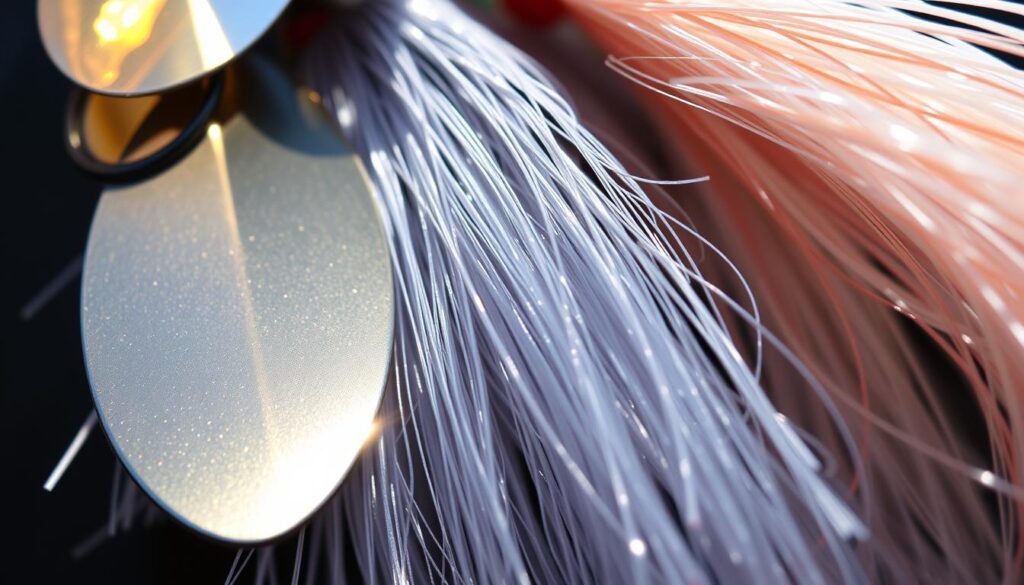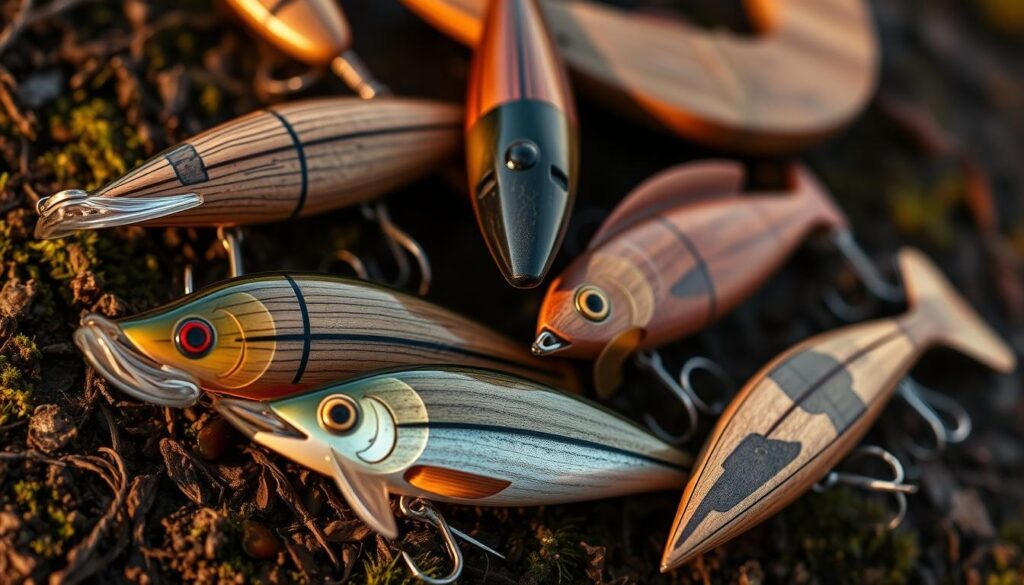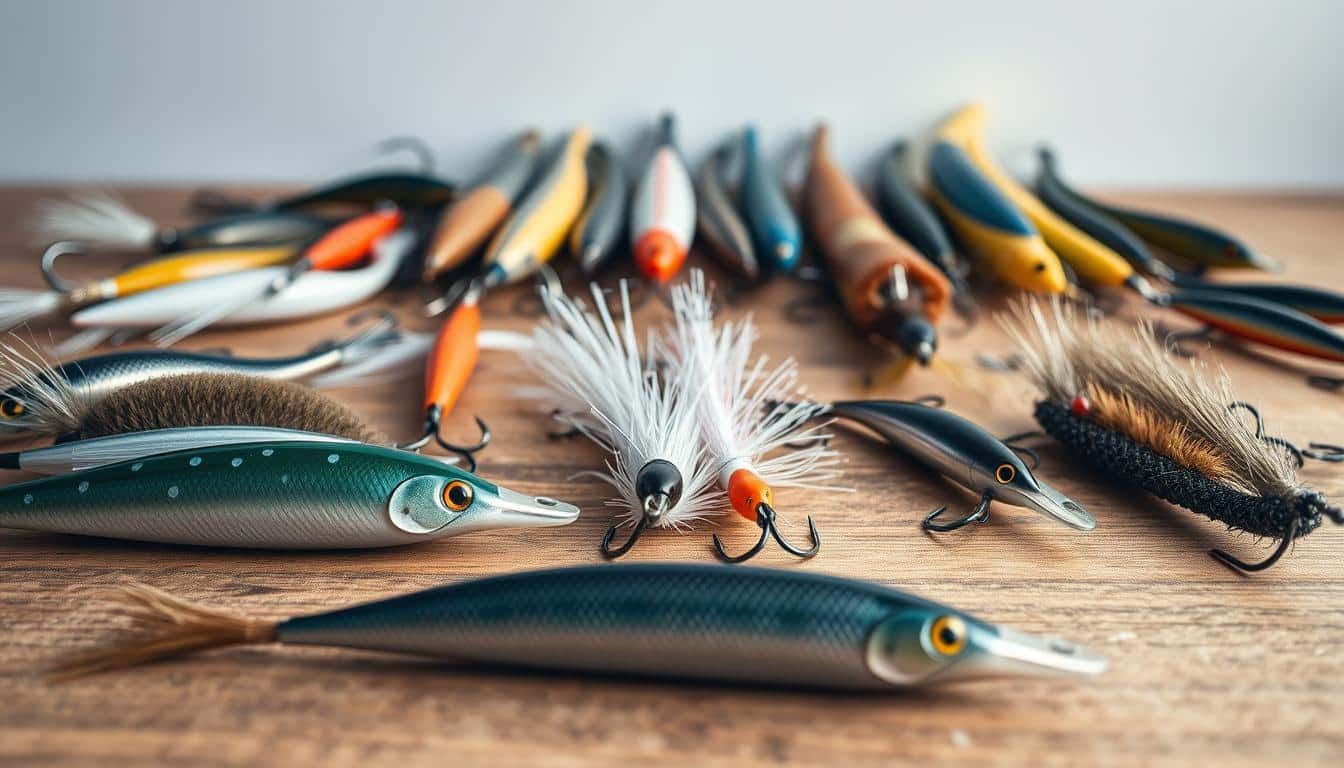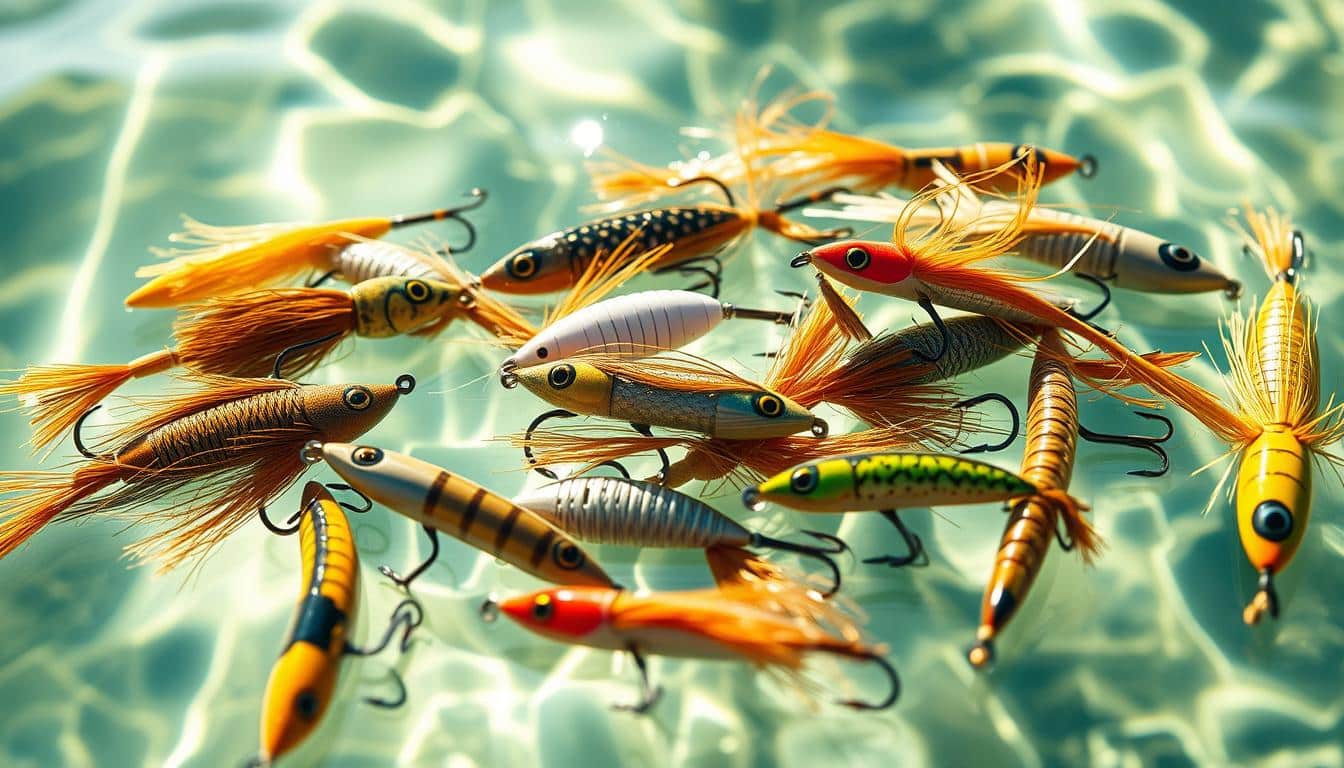Walking into a tackle shop can be overwhelming. A short list of essentials makes decision-making easier. This Top 10 Plastic-Free Lures guide helps build a reliable tackle box without soft plastics.
Trusted for years, classic metal spoons, wooden walkers, and tough jigs are favorites. Brands like Kastmaster and Williams Nipigon show how design affects performance. The details in shape and weight are crucial for choosing lures that work well and protect our waters.
For those starting out, spinnerbaits, single-hook jigs, and lipless crankbaits are great. They’re simple to use and often get through weeds easily. Using these sustainable options helps beginners succeed while caring for the environment.
This series offers tips on using lures without plastics, from how to move them to baiting them. Whether you’re aiming for bass, panfish, or trout, choosing wisely can prepare you for most fishing situations. It helps you fish with confidence every time you’re out.
Top 10 Plastic-Free Lures Every Fisher Should Try
Starting to use non-plastic lures means understanding their benefits. Fishers have always used soft plastics like Senko or Berkley Gulp!. However, options like metal spoons, wooden swimmers, bucktails, and biodegradable alternatives work well too. They work in most water types and seasons without getting lost. This choice keeps tackle boxes well-organized and versatile.
Why choose plastic-free lures
Metal and wood lures last longer. You can easily replace their hooks. You can also retip them with natural bait. This makes them a smart pick for fishers. A small set of these durable baits can do the job of soft plastics. They work well along shorelines, around structures, and in open water.
Environmental benefits and reducing microplastics in water
When you lose a soft plastic lure, it becomes long-lasting litter. By using metal, wood, or biodegradable materials, we lower this risk. This effort helps fight against microplastics. These microplastics hurt our water creatures and the food chain.
How non-plastic lures perform compared with soft plastics
Non-plastic lures are great because they flash, vibrate, and control depth well. Metal spoons and flutter blades move in predictable ways thanks to their shape. On the surface, wooden lures and bucktails disturb the water. Sometimes, they even work better than plastics.
- Metal spoons: consistent flutter, good for cast-and-jig and vertical work.
- Bucktails and spinnerbaits: semi-weedless, single-hook options for heavy cover.
- Wooden topwaters: explosive surface strikes with durable construction.
- Biodegradable swimbaits and natural-material trailers: lifelike action without persistent waste.
Using these options promotes fishing that is good for the environment. Non-plastic lures can match or even beat soft plastics in flash, vibration, and durability. Fishers who care about the environment will face less gear loss. They also help keep our waters clean for the future.
Metal Spoons for Versatile Fishing and Flash
Metal spoons are perfect for anglers who like simple, yet effective lures. These lures mimic hurt baitfish with their wobble and shiny surface. They’re great for many kinds of fish, from small panfish to big pike. You can use them in different fishing situations like casting in open water, jigging vertically, or fishing through ice holes.
Overview of spoon designs and how they attract fish
The shape of the spoon affects its movement. Take the Kastmaster spoon. Its beveled edge slices through water, creating a fast, darting action when you reel it in. Slab spoons move more broadly and slowly which can make fish strike out of sudden interest. Then, there are slender spoons. They move in a tight spin, perfect for catching fish that prefer quick baitfish.
Best uses: open-water casting, jigging, and ice fishing
When casting in open water, just let the spoon’s flash attract the fish as you reel in steadily. If you’re jigging, use short, gentle moves. This lets cautious fish take a good look at the lure. While ice fishing, lifting and pausing the spoon shows off its fluttering descent. That action can get you bites from trout and walleye hanging below the ice.
Examples to try: Kastmaster-style and slender/slab spoons
- Use a Kastmaster spoon for a fast, lively action that interests bass and walleye.
- Choose a slender spoon for its leisurely fall and bright flash. Trout and steelhead can’t resist it.
- Opt for a slab spoon for its wide movement and slow drop. It’s ideal for luring fish in cold water.
Fishing tips: retrieve cadence, short strokes vs ripping, and tipping hooks
Pick a retrieving speed that mimics the prey fish. Slow, even retrieves are good for relaxed fish. Use gentle tugs for when fish seem uninterested. But, try quick, sharp pulls to excite aggressive predators.
Adding something to the hook can make a big difference. Try a minnow head, a piece of worm, or maggots on your spoon’s treble hooks. This adds more smell and looks more enticing. Remember to match the spoon size with the fish you’re targeting: small for panfish, medium for bass and walleye, and large for pike and muskie.
Hard Baits and Crankbaits for Depth Control
Choosing the right hard bait can really change your fishing day. Bill angle, size, and weight decide how deep lures go. So, match your lure to where bass swim and how they act through the seasons.
How bill shape and angle control diving depth
- Bill design diving depth depends on lip length and tilt. Long, steep bills force a lure deeper with less speed.
- Short, square bills keep a crankbait near the surface and bounce off cover to trigger reaction bites.
- Weight placement and body profile affect cycle time; tighter wobble runs shallower while wider-bodied baits often dive deeper for the same retrieve.
Timing shallow vs deep presentations with seasonal patterns
- Use shallow divers in spring and early fall when bass stage near banks and structure. Match retrieve speed to activity level.
- Deep diving crankbaits become essential in mid-summer when fish sit 20+ feet down. Traded depth for loud, long-bodied action when fish are deep.
- Cold water periods often push bass to deep basins. Work deep divers slowly to increase strike windows and respect seasonal bass dive behavior.
Materials, build quality, and tips for hard bait longevity
- Hard bait longevity rises with solid construction: molded wood or durable polymers and quality metal hardware resist cracks and warping.
- Replace weak factory trebles with tough hooks such as Lazer Sharp L774 to improve hookups and extend service life.
- For beginners, pick baits without brittle plastics and favor simpler hook setups for easier hook removal and semi-weedless work.
Match your lure with the water’s depth and the bass’s actions. Test your crankbait’s depth each time you cast. Notice the bill design’s diving depth. Choose durable lures to fish longer. This makes your fishing smarter and helps you understand bass behavior better.
Metal Lipless Crankbaits and Rattling Baits
Metal lipless crankbaits excel in shallow and mid-depth waters. They create vibrations and sounds that break through wind and currents. This attracts fish that are passing by. Use these when you want to quickly explore an area or make predators strike out of impulse.
Vibration and noise as attractors in shallow and mid-depth water
Vibrations are key in murky water where fish can’t see well. The noise and movement of lipless crankbaits act like scared, darting fish. Since fish can hear and feel them from far away, these lures are great early in the morning, late in the day, or in murky waters.
Techniques for rip-and-retrieve through grass and cover
The rip-and-retrieve method is perfect for places with lots of plants or shallow areas. A quick, hard yank makes the lure shoot out of weeds and tempts fish to attack fiercely. Start with gentle tugs for fish that are just curious. Use stronger pulls to excite them more if needed.
- Start with a steady retrieve to gauge reaction.
- Apply quick rips to trigger aggressive fish in schools.
- Vary cadence: short-stroke for tentative bites, full rip for reaction strikes.
Selecting sizes and colors for targeting different species
Choosing the right lure size is based on what fish normally eat in that area. For big fish like pike, large bass, and walleye, go for larger lures. Smaller ones are better for panfish and crappie. With colors, use lifelike shades for clear waters. In murky conditions, opt for vivid or shiny lures to stand out.
- Large lipless baits for big predators; small baits for schooling panfish.
- Natural hues in clear water; brighter or metallic tones in stained water.
- Prefer single-hook rigs or reduced trebles when fishing heavy cover to limit foul-ups and speed hooksets.
Spoons and Flutter Blades for Vertical Jigging
When planning a vertical jig, choosing the right metal is key. Anglers compare flutter spoons to slab spoons. They look at how fast they fall and how shiny they are. Even small shape changes affect how they move, sound, and keep a fish’s interest.
Design differences and cycle time
Slab spoons, like those Kastmaster-style ones, fall quickly and wobble tightly. This is perfect when fish like quick moves. On the other hand, flutter spoons, which are thinner and PK-style, fall more slowly. They shimmy longer, giving off more sparkle as they go down. Use a slab for quick bites and a flutter when you need to catch a fish’s gaze.
Best applications for these lures
- Ice fishing spoons are great for catching perch, walleye, and crappie.
- Flutter profiles are best for chasing fish that are picky and hang back.
- Adding a spoon to a dropper rig makes it more attractive, while a minnow or maggots can be presented below it.
Practical tips to boost hookups
- Add minnow heads to walleye hooks, maggots for panfish, or softbait pieces for crappie.
- Try little nods, followed by a pause and then a quick shake, to make fish bite.
- Keep the leader on dropper rigs short, about 2–2.5 inches, to avoid tangles and keep your spoon near the bait.
Spinnerbaits and Bucktail Spinners for Cover and Search Fishing
Spinnerbaits and bucktail spinners are great for anglers who value versatility and durability. They work well around thick cover thanks to their single-hook metal skirts and blades. Their design allows for easier casting near brush and wood, sliding through with less snagging.

The type of blade and skirt affects what kind of bite you’ll get. Willow-leaf blades are good for clear water because they flash without much vibration. Colorado blades, which are rounded, produce a strong vibration ideal for murky waters and dense cover. Pick skirt colors that mimic local prey, like white for shad or green for bluegill.
Spinnerbaits are perfect for quickly covering water to find where fish are biting. A steady retrieve helps you identify active fish along various underwater landscapes. Once you find them, you can switch your technique to targeted moves to catch them more effectively.
- Choose a spinner with the right blade size to get the perfect mix of flash and sound.
- Have different skirt colors ready to match what the fish are eating.
- For those new to fishing, single-hook spinners are easier to use and better for catch and release.
To cut down on fishing time, use simple search bait techniques. Begin with a medium retrieve, exploring different depths. When you hit a spot with fish, slow down and tweak your bait for better chances of catching them.
Jigs with Natural Trailers for Structure Fishing
Jigs with natural trailers act lifelike around docks and rock piles. They look like crawfish and baitfish, without using single-use plastics. For those preferring tough hooks and big heads, these jigs work well in tight spots.
Jig heads and natural-material trailers as plastic-free combos
Choose marabou, deer hair, or minnow bits for special moves that trick smart bass. These natural materials move differently than rubber, giving a better look as they fall. Brands like VMC and Gamakatsu offer strong hooks for these jigs.
Techniques: flipping, dragging, hopping, and slow crawls
- Flipping jigs into tight spots makes bass bite; keep it close to cover.
- Dragging a jig on the bottom can make fish hiding there bite.
- Make your jig hop to act like a crawfish on the run; stop often for effect.
- Slow moving works best in shady places where bass like to hide and eat.
Matching jig color to forage: crawfish, shad, and bluegill patterns
Choose jig colors that look like local food. Browns and reds for crawfish. White and grey for shad. Green and blue mix well for panfish looks. Using the right colors helps catch more bass when they prefer certain food.
Beginners should try a single-hook jig with a natural trailer. It should also have a strong hook for thick places. Keeping it simple, aim for the bottom and let the trailer work for you as you explore.
Metal Spoons Paired with Dropper Rigs and Live Tips
Pairing metal spoons with short droppers makes a shiny, active lure setup. It’s great for catching panfish, perch, crappie, and walleye. Use a spoon to grab attention and add something small like a jig or live bait to get fast bites.
To keep the rig from tangling, follow easy steps while setting it up. Switch out the usual hooks for a smaller leadhead or a lone hook on short mono. Using products like StringEase Fastach helps your bait move naturally. Plus, the spoon’s weight helps sink it properly.
Building a dropper rig for panfish and species that like cold water
- Pick a sturdy spoon, like those from Hali or Kastmaster, that works with droppers.
- Attach a mono dropper, around 2–2.5 inches long, to your spoon with a split ring or swivel.
- Then, hook up a tiny leadhead jig or a single hook to that leader. Finally, add maggots or a minnow head for extra appeal.
How using live or natural bait improve your chances of catching fish
- Adding live bait like maggots or minnow heads brings scent and movement. It’s attractive to fish nearby.
- Choose between treble or single hooks based on what’s allowed and what you’re fishing for to catch more.
- It’s smart to change your maggots often when seeking perch or crappie. This keeps them active and interesting.
Suggestions on depth and how long your leader should be to prevent messes
- Opt for heavier spoons to go deep quickly. Use lighter spoons for fishing closer to the top.
- Keep your dropper rig’s leader short, around 2 to 2.5 inches. This helps avoid tangles and keeps the bait close to the spoon’s action.
- Choose your spoon size based on the fish you’re after: smaller for panfish and bigger for walleye. Tailor the weight to manage how fast it sinks.
Tips for using live bait more effectively involve changing to sharper hooks, ensuring clips move easily, and swapping out bait regularly in colder waters. Making these tweaks to your dropper rig and keeping leaders short helps keep everything lively. It also improves your chance of getting bites while using spoons with live bait.
Wooden Topwater Baits and Walking Baits
Surface presentations can really excite fish, causing wild strikes. Wooden topwater baits mimic fleeing baitfish well. They float naturally. Anglers like walking baits made of wood for their versatility. They stay realistic despite changes or fixes.

Here are tips to improve your action and catch more fish.
- Surface action that triggers explosive strikes
Walking baits that glide side-to-side can make bass strike hard. Wooden lures have special weight placements. They splash, attracting fish. Mix quick rod moves with steady reel action to get bites.
- Why wood can outfish plastics for topwater presentations
Wooden baits feel real to fish, floating differently than plastics. From Rapala tubular swimmers to carved walking baits, their look and sound are special. They work great in clear waters or light winds, looking more natural.
- Retrieve styles: walk-the-dog, twitch-and-pause, and steady retrieve
To do the walk-the-dog, use short rod flicks with reel turns. For careful fish, twitch then pause, acting like an injured baitfish. For constant action, like with buzzbaits, keep a steady retrieve.
Start with a well-known brand or a traditional wooden lure and practice in calm water. With experience, you’ll know when to use wooden or plastic lures. Also, which styles match the local fish’s favorite snacks.
Frog and Hollow-Body Alternatives Using Natural or Synthetic Non-Plastic Materials
Topwater frog lures work well in thick cover without needing plastics. Anglers have choices like sealed wood, cork, biodegradable materials, and textile skirts. These materials provide realistic movement and help cut down on plastic use. They keep the lure’s action on the surface good and make hooking fish easier, all while being better for our planet.
Weedless options built for thick vegetation
Look for baits with single-hook weed guards or hidden hook paths for smooth movement through plants. A well-set-up weedless frog can glide over weeds and bounce off cover with less trouble than traditional plastics. Companies known for making soft plastics now draw inspiration from hollow designs. Newer brands are using cork or sealed wood to achieve the same effect without lasting plastic waste.
How material choice changes float and surface action
The type of material affects how well a lure floats and moves. Wood and cork stay higher on the water, making a sharper sound with a quick rod jab. Biodegradable materials allow for changes in how the lure walks and reacts when a fish strikes. By adjusting the lure’s skirt thickness and hook cover, anglers can better manage the bait’s collapse and hook exposure.
Retrievals that work on pads, mats, and laydowns
Three methods are reliable in thick cover: gliding over openings, twitching near pad edges, and quick jerks for sudden strikes. Adjust how you move the lure based on what the local fish eat. Fast tugs can make fish chase the lure in warm water, but slow movements are better in cold. Choose a weedless frog with a strong hook for easy catches and safe releases in heavy vegetation.
- Steady walking to draw lateral strikes along open seams.
- Twitch-and-pause to bounce off lily pad edges and reed tips.
- Short ripping for explosive surface takes from ambush fish.
Paddle-Tail and Swimbait Alternatives Using Biodegradable or Natural Materials
Anglers now have better choices for lifelike action without using plastic. Biodegradable swimbaits and natural-material options aim to copy traditional paddle-tails’ movement. They also break down after being used, reducing pollution and protecting our waters for the future.
These options are great if you want the swim action without the plastic waste.
- Biodegradable polymers are made to be soft and break down, yet still move like real fish during multiple catches.
- Soft natural rubber mixes offer the movement of paddle-tails and hold scents better than some materials.
- Combos of wood and feather with a carved body and a flexible tail vibrate like actual fish.
Options for anglers wanting lifelike action
Choose the right size and shape based on the local fish. Big alternatives are good where there are large shad or perch. Smaller ones fit better with the baitfish seen in spring and fall.
The color of your lure is key. Use natural colors in clear water. Use bright or contrasting ones in dark water. Picking a lure that looks like local prey like shad or perch gets you more catches.
Rigging methods: jigheads, single hooks, and weights
Different rigs are needed for each situation. Jigheads are good for open water and consistent reeling. Use single-hook, weedless rigs to keep your lure safe in thick plants.
Add weights to fish in deeper waters. A gentle reel with small jerks can make your lure seem like a hurt fish. Adding natural bait, like a bit of minnow, can make your lure more tempting.
Seasonal uses and matching forage size
Your lure choice should consider water temperature and prey size. In summer, bigger lures are better for deep water and active fish. In spring and fall, use smaller lures for feeding fish.
Change your weight and how fast you reel in with the seasons. Lighter setups and slower movements are best in cold water. Use heavier gear and quick actions for active fish.
Using biodegradable options keeps our waters clean and fishing effective. With the right non-plastic rigging and seasonal choices, you can fish well and keep the environment safe.
Conclusion
A few select sustainable fishing lures are all you need for fishing in lakes, rivers, and the sea. This includes metal spoons, hardbaits, wooden topwaters, spinnerbaits, jigs with natural trailers, and eco-friendly swimbaits. This gear helps you fish without plastic and still catch fish all year.
Metal and wooden lures are great because their shapes and weights make them move in predictable ways. Try your lures in a tank or lake to get the hang of how they move. Upgrading hooks and rings makes them last longer and catch better.
For both new and experienced fishers, these non-plastic lures make fishing simpler. They often come with hooks that don’t snag easily, helping you release fish safely. Match how you reel in the lure with the season and what fish eat, using real bait if needed. Stick to these top eco-friendly lures to cut down on plastic and keep your catch rate high.
FAQ
What are the top plastic-free lures every angler should have?
Why choose plastic-free lures over soft plastics?
How do non-plastic lures perform compared with soft plastics?
What makes spoon designs different and how do they attract fish?
When should I use spoons for open-water casting, jigging, or ice fishing?
Which spoon examples are recommended to try first?
What retrieve tips improve spoon success?
How does bill design control diving depth for crankbaits?
When should I use shallow versus deep divers for bass?
What materials and build quality should I look for in hard baits?
How do lipless metal crankbaits attract fish in shallow and mid-depth water?
What techniques work best for ripping lipless baits through grass and cover?
How should I choose sizes and colors for different species?
How do flutter and slab spoon designs differ for vertical jigging?
When are spoons with dropper rigs and vertical presentations most effective?
What tips help when tipping treble hooks and using short nods or shakes?
Why are spinnerbaits and bucktail spinners good for cover and search fishing?
How does blade shape and skirt combination change spinnerbait action?
When should I use spinnerbaits as a search bait versus a targeted presentation?
What makes jigs with natural trailers effective for structure fishing?
What techniques work best with jigs: flipping, dragging, hopping, or slow crawls?
How should jigs be matched to forage and cover toughness?
How do I construct a dropper rig using a spoon and live tip for panfish or walleye?
Which spoon models work best for dropper rigs and vertical presentations?
Why use wooden topwater baits and what surface actions trigger strikes?
What retrieve styles work best with walking and topwater baits?
What are plastic-free frog and hollow-body alternatives for heavy vegetation?
How does material choice affect buoyancy and frog action?
What retrievals are best for pads, mats, and laydowns with non-plastic frogs?
What paddle-tail and swimbait alternatives exist that avoid persistent plastics?
How should biodegradable or natural swimbaits be rigged?
How do I match lure choices to seasons and forage?
What simple upgrades and maintenance improve plastic-free lure performance?
Content created with the help of Artificial Intelligence.



